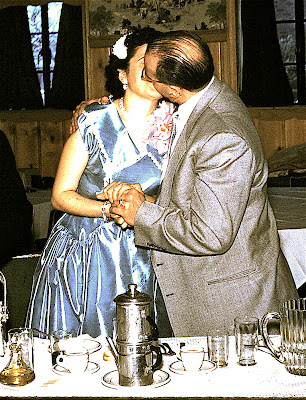This year I hosted not one but two ladies on Valentine's Day. Shyster Jersey Lawyer Friend came by the
casa, see, and I had been earlier made wise to the fact that she was desirous of some meat. (Pasta is what the woman normally seeks, preferably the homemade variety, so as to require the maximum amount of effort on my part.)
Shyster's desires provided an opportunity to try a recipe that I had been eyeing for some time: "The Best Veal Osso Bucco," from Andrew Carmellini's cookbook, "
Urban Italian."
I know. Where does he get off, right?
Except that the only other recipe in the chef's book that receives such a designation is "The Best Gnocchi." I've made it. And he's right. I told him so just recently, outside the men's at his newest restaurant in New York,
The Dutch. I'll show the gnocchi to you here sometime, you'll see. They're fantastic.
If you enjoy osso bucco and are in the market for an interesting way to prepare it, this recipe certainly is that. The liquid that the veal is cooked in is two parts chicken stock, one part freshly squeezed orange juice. There's only one diced tomato to be found, something you wouldn't guess from looking at the final outcome. (Hint: strands of saffron were seen in the vicinity while I was cooking and pounding back a Booker's.)
Anyway, the full recipe is reprinted below. Here are just some of the steps along the way.
First, the well-seasoned veal is seared on both sides in a dutch oven over high heat, then removed.
Then the carrots, celery, onion, garlic and such get to work. And also the tomato and a little flour.
There's white wine in here too, and once it evaporates some, it's time to bring back the veal.
Some more herbs, and lemon peel are added at this point, and then the stock and the orange juice. Next stop is the oven.
Two hours later and this is what you've got. (Actually, two hours and a full day later is when it was eaten. This kind of dish always tastes better after it has sat in the fridge overnight, and so I made this the day before V-Day.)
Is it the best osso bucco I've ever had? No. But it's definitely among the top five.
The ladies liked it a whole lot. Which is what mattered.
The Best Veal Osso Bucco
Recipe
Adapted from "
Urban Italian," by Andrew Carmellini and Gwen Hyman
4 pieces veal osso bucco (about 3lbs total)
3/4 tsp salt
1/2 tsp course-ground black pepper
2 tbsp plus 1 tbsp extra-virgin olive oil
1 small carrot, chopped (1/2 cup)
1 medium onion, chopped (1 cup)
1 stalk celery, chopped (1/2 cup)
2 garlic cloves, whole
1 large tomato, chopped (1 cup)
2 tbsp tomato paste
1 1/2 tbsp all-purpose flour
1/2 cup white wine
a pinch of saffron (about 10 threads)
juice of 3 oranges (about 1 cup)
2 dried bay leaves
1 sprig fresh thyme (or 1/2 tsp dried)
1 sprig fresh rosemary (or 1/2 tsp dried)
1/4 tsp red pepper flakes
1/4 tsp whole fennel seed
2 cups chicken broth
3 to 4 curls lemon peel
1. Preheat the oven to 375F.
2. Season both sides of the osso bucco with the salt and pepper.
3. Heat 2 tbsp of the olive oil in a large pot over high heat. Add the osso bucco and brown on both sides, about 10 to 15 minutes.
4. Remove the osso bucco from the pot and reserve it. Leave the pot on the stove over high heat.
5. Add the remaining olive oil to the pot, and then add the the carrot, onion, and celery. Stir well and allow the vegetables to soften and caramelize, about 4 minutes. Be sure to scrape the brown bits from the bottom and sides of the pot as you go.
6. Add garlic, tomato and tomato paste. Mix and cook until the tomato softens, about 1 minute.
7. Add the flour and stir until ingredients are well combined, about 1 minute.
8. Add the wine and allow it to evaporate just until the mixture becomes a loose paste, 1 to 2 minutes.
9. Stir in the saffron and orange juice. Return the osso bucco to the pot and turn the heat to low. Coat the meat in the sauce.
10. Tie the bay leaves, tyme and rosemary together with butcher's string (so that it can be removed easily before serving) and add to the pot; then add the red pepper flakes, fennel seed, broth and lemon peel.
11. Cover the pot and bring the liquid to a low boil, then put the pot in the oven and cook at a lazy bubble for about 2 hours. Flip the meat over at the halfway point. It is done and ready to serve when fork tender. But the flavors will enhance if left in the fridge overnight and reheated the next day, so consider making this dish a day in advance.














































